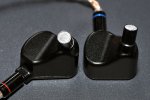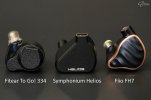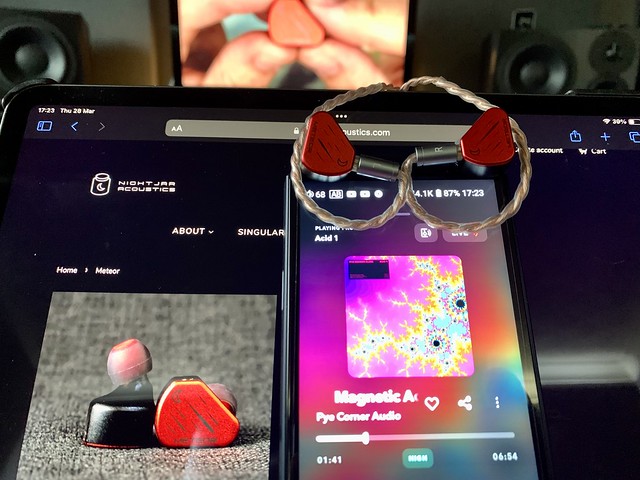



Helios - Technical Reference
TrueX™ 4-Way Crossover FLAT™ Technology Full Balanced Armature Design Tuned in Collaboration with Subtonic. Anodized AL6061 Aluminium Shell Azla Sednafit Standard and Sednafit Short Eartips 26AWG Altalune Nova in 4 Wire Configuration Available in 3.5mm and 4.4mm terminations Hand-Crafted in...
Conceptualized in early 2015, Symphonium has started to enter the high-end IEM market with their flagship IEM, the Helios. A 4-Way multi-driver balanced armature IEM.
MSRP: $1,099
Disclaimer:
Symphonium provided this IEM to me as a review sample in exchange for an honest and unbiased review. The company is not involved in any measurement process and editorial content of this review.
Notes: On the last 2 pictures above, the Left and Right connectors were reversed. I was taking pictures of the IEM drivers without cable then wrongly connected the Left and Right connectors to the drivers when taking the above pictures.
Durability, impedance linearity, and extended frequency response seem to be some of the important features of Helios. The shell is made of artificially tempered AL6061 Aluminium alloy to improve strength and hardness. And it is among few IEM models that utilize spring-loaded 0.78mm 2-Pin socket for maximum durability and consistent electrical contact even with frequent cable replacement. This is good news for cable aficionados because they can do cable replacement as often as they like on Helios without causing the 2-Pin socket to get loose. I swapped the cable many times between the stock 2.5mm cable and my 3.5mm cable and the grip of the 2-Pin socket is still consistent till now.
A common problem with multi-driver IEM is impedance linearity. It is often that the non-linear impedance curve of a multi-driver IEM causes tonality shift when connected to headphone output with relatively high output impedance. Helios is designed with a close to flat impedance curve for consistent tonality across multiple devices. This is a rare feature for a 4-way multi-driver IEM.
I measured Helios several times to check the consistency of my measurement and keep seeing that 20kHz frequency response sticks out like no other IEMs I’ve ever measured before. And the clean extended sub-bass response is quite impressive from a fully balanced armature IEM. Helios is a kilo-buck IEM and it seems to deliver what is expected from a kilo-buck IEM.
Pros:
Highest 20kHz frequency response ever measured.Very low overall harmonic distortion.
Close to flat impedance curve.
Spring-loaded 0.78mm 2-Pin socket.
Cons:
Relatively large shell size and nozzle diameter (5.74mm) may not be suitable for those with a smaller ear canal.Suggestions:
To improve shell shape and size for better fit and comfort. The shell is a bit too large and protruding out from the ear. And to slightly reduce the nozzle diameter for better fitting.The following is my guideline for the sound & engineering quality rating criteria that will be used in this review:
Sound Quality
Measured frequency response is compared to Earfonia IEM Target Curve (EITC-2021):*More info about EITC-2021 here.
Symphonium Helios measured frequency response normalized at 94 dB SPL @ 500Hz:
Symphonium Helios measured frequency response normalized at the midrange dip:
Symphonium Helios measured frequency response in comparison to Harman Target IE 2019:
The following is frequency analysis based on the 4 observation points on EITC-2021:
Overall Sound Signature:
Mild V-shape tonality with clarity-oriented tuning. Excellent sub-bass and upper treble extensions.From the frequency response graph, we can observe the followings:
- Helios frequency response is within ±3 dB from my EITC-2021 observations points.
- Helios frequency response around the bass and midrange area is within ±3 dB from the Harman Target IE 2019.
- The midrange peak (Mp) and 1st treble peak (T1p) are pretty close to my preferred target.
- The mid-bass to low-mid area is a bit recessed.
- Besides the T1p at around 4.26kHz, there is another treble peak close to it at around 5.57kHz. Since T2p is the expected resonance peak, I call this 5.57kHz peak the 3rd treble peak or T3p. I’ve seen this T3p on other IEM like the Fiio FH7. From what I’ve observed, the effect of T3p seems to enhance the perceived clarity.
- So far, I’ve never seen a 20kHz measured response as high as the Helios. A very interesting phenomenon. I measured several times to check consistency and the results are consistent. Helios is the only IEM that I’ve ever measured with this kind of ‘real' 20kHz upper treble extension. Remarkable! It also shows that my measurement setup can measure up to 20kHz.
The lower midrange sounds a tad recessed and the midrange body sounds a bit lean on vocal. I prefer a slightly fuller and warmer midrange. I guess Helios is not meant for those who are looking for warm and lush-sounding mids, instead, detail and clarity are the main themes here. The midrange probably can be described as 'neutralish' clean-sounding midrange with a high level of perceived detail and clarity. When listening to female vocals sometimes I hear some emphasis on the breathing sound a bit more than what I used to hear from my other favorite IEMs. Helios sounds ok with vocals but may not be my first choice of IEM for vocals as I prefer a fuller-sounding vocal. Instead, I think it is among the best IEM for instrumental and orchestral works.
Bass is tuned to emphasize more on the sub-bass, likely to avoid bass bloat that often spoils the mids. There is no bloated or boomy bass here, bass sounds super tight and deep. And the bass can be quite thunderous when the music calls for it. The mid-bass punch is good, but I prefer a tad more mid-bass body to improve the overall balance between sub-bass and mid-bass.
Treble is the pinnacle of Helios tonality, as the overall tonality is slightly emphasized in the treble area. The treble sounds very smooth with probably the best upper treble extension that I've ever heard. Helios treble tuning is executed brilliantly. I have no problem with sibilance even when listening to a rather bright vocal recording. There is no sharp or peaky shrill treble but flaws in the bad recording will be revealed without mercy. The treble tuning makes the Helios shines.
Perceived detail and clarity are the most prominent aspects of the sound signature. Helios is a master of perceived detail and clarity. Another quality that impressed me is the instrument separation and positioning that are presented with surgical precision. I’m a fan of David Garrett but I often don’t get the level of instrument separation that I would like to hear from his recordings. Helios solves this issue, and it has been my first choice of IEM for listening to David Garrett's albums and other similar orchestral works. Transient and attack are lightning-fast while the boosted sub-bass adds power and liveliness to the dynamic. Helios is a lively sounding IEM, not by boosting the bass as many IEMs do, but by presenting music with lifelike detail and clarity.
Comparisons to FitEar To Go! 334 & Fiio FH7

FitEar made its debut around a decade ago and I was a fan of the ‘To Go! 334’ smooth warm and pleasing sound signature. In the last few years, I have done quite a lot of audio recording and mixing work, and that changed my personal preference for sound quality. My requirement for perceived detail and clarity increases because those qualities help me to hear more detail during recording and mixing. Now I feel FitEar To Go! 334 sounds a bit too warm. Helios sound more neutral and has higher perceived detail and clarity with better instrument separation than the To Go! 334. I would choose Helios over To Go! 334 any time of the day.
Fiio FH7 has 3 tuning filters: Green, Black, and Red. The Green filter is just a mesh without any filter, while the Black and Red filters dampen the treble in different degrees. Most of the time I use the Green filter as it sounds the most transparent to me. The FH7 with the Green filter sounds a bit more balance and less V-shape than Helios. The midrange sounds fuller and nicer on vocals. From the tonality perspective, I would say FH7 tuning is the better all-rounder than Helios by a small margin, while Helios still has the edge for perceived detail, clarity, and instrument separation. Helios also sounds a bit dryer compared to FH7. Both are nice IEMs and although they have a different sound signature, in my book sound quality wise they are in the same league. I would take the FH7 for vocal and Helios for instrumental and orchestral works. But on other technical aspects like Left-Right mismatch, distortion, and impedance linearity, Helios wins.
Equalization to Match EITC-2021
One of the objectives of my EITC-2021 target curve is that it is a ‘realistically achievable target curve’ by my measurement equipment. It is based on real measurements and not just an estimated target curve. To test and experience an IEM with matching frequency response to EITC-2021 sounds like, I created an equalizer profile for Symphonium Helios to match EITC-2021.Symphonium Helios frequency response (Red curve) after equalization to match EITC-2021 target curve (Blue curve):
To me, EITC-2021 equalization improves Helios' tonal balance. The midrange sounds more natural. I use REW to create the equalizer profile based on the difference between Helios' average response and EITC-2021. Then exported the equalizer profile as a text file to be loaded to Equalizer APO.
Below is the download link for the equalizer profile for Symphonium Helios to match the EITC-2021, so anyone who would like to try EITC-2021 on their Symphonium Helios can load it to Equalizer APO to test it. Please apply a -3dB gain to avoid clipping.
Symphonium Helios to EITC-2021 EQ APO v1.3
Engineering Quality
Disclaimer: The measurement results of the engineering quality measurement in this review represent only the pair of IEM that was measured for this review. It doesn’t represent the overall quality control of the factory.
Left-Right Match
Observation range: 20Hz – 7kHzThe review sample of Helios shows excellent left and right channel tracking. My unit has an overall 0.5dB matching from 20Hz-5kHz, with only 1.2dB maximum at around 5.4kHz.
Harmonic Distortion
Observation range: 55Hz – 7.1kHzOverall THD level of the Symphonium Helios is quite low even at the peak. Left and Right channels show similar THD profiles. There is no abnormal distortion peak across the measurement range. Please take note that distortion measurement is not part of sound quality evaluation. It is only used to observe the engineering quality of the IEM.
Distortion measurement at 94 dB SPL at 500Hz:
Distortion measurement at 104 dB SPL at 500Hz:
An interesting observation of the harmonic distortion profile, in general, the odd harmonics are higher than the even harmonics. Probably that’s what gives the analytical nature to the sound signature of Helios. But since the overall distortion level is quite low, I don’t consider it a concern.
Electrical Impedance
Observation range: 20Hz – 20kHzThe impedance curve is almost ruler flat, with only a gentle roll-off after 13kHz. I’ve never measured a multi-driver BA IEM with impedance as linear as Helios before. This is an engineering quality that deserves acknowledgment. The following is the impedance curve of the Left and Right channels of Helios, Fiio FH7, and FitEar To Go! 334 for comparison.
Zoomed in:
Sensitivity
At 92.9 dBA SPL at 100mV @ 1kHz Helios’ sensitivity is quite low, lower than the Etymotic ER2XR which is already quite low. But my old mobile phone, Samsung Galaxy S9+, still can drive Helios to a sufficient loudness level. So, in most setups, it is not a concern. Most portable devices would be able to drive Helios sufficiently, but a good quality DAC+Amp will improve the perceived dynamic, liveliness, and overall sound quality. I suspect the low sensitivity could be due to a resistor network inside the IEM that is used to flatten the impedance curve.Fit, Comfort, & Build Quality
Besides the regular Silicone ear tips, Helios comes with ‘Azla SednaEarfit’ ear tips which feel more rubbery than regular Silicone ear tips. To me, the ‘Azla SednaEarfit’ gives slightly better comfort and grip.The shell nozzle is lipless, but I don’t have a problem with ear tips sliding off the nozzle. Probably the large nozzle diameter and the matte finish of the surface help to grip the ear tips quite well. With around 5.74mm nozzle diameter, I would advise those with smaller ear canals to consider testing the fitting before buying Helios. I always use medium-size ear tips with other IEMs, but with Helios and ‘Azla SednaEarfit’ ear tips I use the small size ear tip for better fitting. Fitting could be an issue for those who usually use small size ear tips.
Helios' shell size is rather large. In my opinion, the shell thickness is rather too thick that it tends to protrude out of the ear. And I would suggest the part shown in the 2nd picture below be curved in for a better fitting. I asked Symphonium Audio why the shell size is that large, and they said it is due to the high-quality components that they use requiring more space inside the shell.
I have used Helios for long listening sessions as well as mixing my recordings. I consider the fit and comfort are ok but not great. Subjectively I would rate the comfort level as 7/10. Aesthetically I’m not a fan of large and thick shells, and I hope Symphonium could come up with a better shell design for their future IEMs.
Left and Right indicators are on the cable connectors. To connect the driver with the correct polarity, the groove of the connector is to face the outer side of the shell.
Build quality of Helios is generally very good. The shell feels very solid and durable. I’ve used them for about 2 months without extra care, and I don’t see any scratches on the shell surface. It seems that it is built to last.
Metal Shell to Ground Pin Connection: Not connected
Recommendation:
Suitable for critical listening and Pro Audio applications, and any other applications where a high level of perceived detail and clarity, wide frequency extension, and linear impedance curve are important.Kudos to Symphonium Audio, the Helios achieved ALL GREEN on all my quality ratings!
More information about my IEM Measurement Setup & Methodology:
Earfonia IEM Measurement Setup & Methodology
Advertised Technical Specifications:
Driver Crossover: Custom Tuned True 4-Way Crossover with FLAT TechnologyFrequency Response: 12Hz - 24kHz, ± 2 dB
Sensitivity: 104dB/Vrms @ 1 kHz
Impedance: 8.5 Ohms @ 1 kHz
Socket: Spring Loaded 0.78mm 2-Pin
Cable: 26 AWG Pure OCC Copper
Cable Impedance: 0.20 Ohms (2.5mm), 0.25 Ohms (3.5mm), 0.28 Ohms (4.4mm) @ 1kHz
Warranty: Limited 1 - Year Warranty


